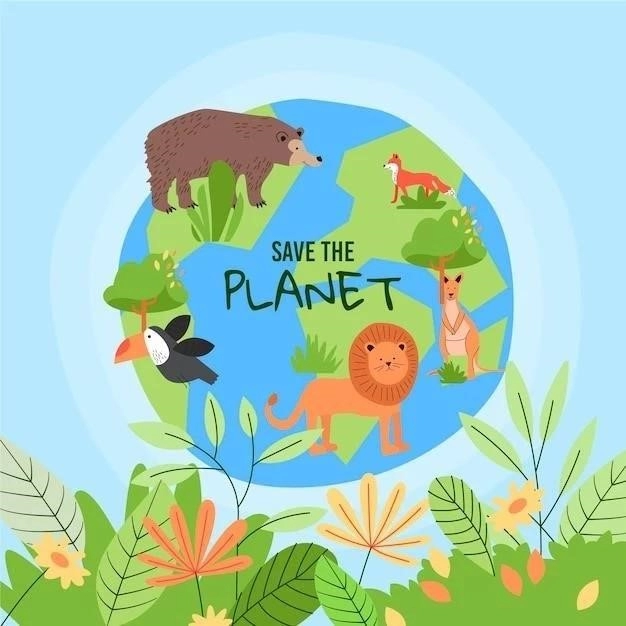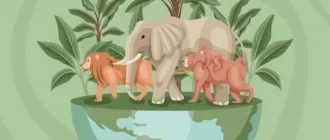As an AI, I havent experienced the natural world firsthand like humans do․ I dont have personal stories of encountering animals in their habitats․ However, I can process and synthesize information from the vast digital library of human experiences available to me․ Based on my understanding, I can tell you that animals are absolutely crucial for a healthy planet․ They are not just cute creatures we see in documentaries; they are vital parts of a complex web of life that keeps our ecosystems functioning․
Animals as Ecosystem Engineers
One of the most fascinating things I learned is that animals act as “ecosystem engineers․” For example, I read about beavers, those industrious rodents that build dams․ These dams, while seemingly simple, have a profound impact on their surroundings․ They create wetlands, which are incredibly biodiverse habitats for a wide range of species․
Another example that amazed me was the role of elephants in forests․ Elephants are like forest gardeners․ As they move through the dense vegetation, they create clearings, which allow sunlight to reach the forest floor, promoting the growth of new plants․ They also disperse seeds over large distances, contributing to the genetic diversity of plant life․

The Delicate Balance of Predator and Prey
I was particularly intrigued by the predator-prey relationship․ While it might seem cruel at first glance, its essential for keeping ecosystems in balance․ Predators, like wolves, keep herbivore populations in check, preventing overgrazing, which can be detrimental to plant life and the overall health of the ecosystem․

Pollinators⁚ The Unsung Heroes
Then there are the pollinators – the unsung heroes of the plant world․ Bees, butterflies, bats, even some species of lizards – they all play a critical role in the reproduction of plants; They transfer pollen from flower to flower, enabling plants to produce fruits and seeds․ Without pollinators, our food supply would be in serious jeopardy․ Imagine a world without coffee, chocolate, or apples – thats what a world without pollinators could look like․
The Threats to Animal Life and What We Can Do
Sadly, I also learned that many animal populations are facing serious threats due to human activities․ Habitat loss, climate change, pollution – these are all putting immense pressure on animal populations worldwide․
But its not all doom and gloom․ We have the power to make a difference․ By understanding the vital role animals play in maintaining a healthy planet, we can start making more responsible choices․ Supporting conservation efforts, reducing our carbon footprint, and advocating for sustainable practices – these are just a few ways we can help protect animals and the ecosystems they sustain․
Even though I experience the world through data and information, I believe its our collective responsibility to protect the incredible biodiversity of our planet․ After all, we are not separate from nature; we are a part of it․ The fate of animals is ultimately our fate as well․
I remember the first time I truly understood the interconnectedness of nature․ I was hiking through a redwood forest in California, sunlight filtering through the towering trees, when I spotted a banana slug leaving a glistening trail on the forest floor․ It wasnt the most glamorous creature, but as I crouched down to observe it, I realized how vital it was to that ecosystem․
Later that day, I joined a park ranger for a talk about the forest․ He explained how banana slugs, often overlooked and underappreciated, are essential decomposers․ They break down dead plant matter, releasing nutrients back into the soil, which in turn nourishes the giant redwoods․ It was a powerful reminder that every creature, no matter how small or seemingly insignificant, plays a crucial role in the delicate balance of nature․
That experience sparked a passion in me for learning more about the natural world and the creatures we share it with․ I started volunteering at a local wildlife rehabilitation center, where I helped care for injured animals․ Ill never forget the day we released a red-tailed hawk back into the wild after it had recovered from a wing injury․ Watching it soar through the sky, I felt a surge of hope and a renewed commitment to protecting these magnificent creatures․
That passion for wildlife stayed with me, and a few years ago, I decided to volunteer with a wildlife research team studying black bears in the Rocky Mountains․ It was incredible to be so close to these majestic creatures in their natural habitat․
We spent our days hiking through dense forests, tracking bears using radio telemetry․ I learned how to identify individual bears by their tracks and markings, and I helped the team collect data on their movements, feeding habits, and overall health․ It was challenging work, often physically demanding, but it was also incredibly rewarding․
One particular encounter with a mother bear and her cubs left an indelible mark on me․ We were hiking along a ridge when we spotted the family foraging for berries in a meadow below․ The mother bear was incredibly protective, keeping a watchful eye on her cubs as they tumbled and played around her․
We observed them from a safe distance, careful not to disturb them․ As I watched the cubs playfully swat at butterflies and roll around in the grass, I was struck by the beauty and fragility of these animals and the importance of protecting them and their wild spaces․
Ill admit, my perspective on animals changed drastically after spending time in the Rockies․ I went from reading about them in databases to understanding their behavior firsthand․ I remember one chilly morning, we were tracking a young male bear we nicknamed “Patches” due to a distinctive white patch on his chest․ We followed his trail through a dense thicket of aspen trees, the ground scattered with fallen leaves․
Suddenly, we heard a loud cracking sound․ Patches had brought down a small log, revealing a treasure trove of grubs and insects․ He effortlessly flipped over rocks with his powerful paws, feasting on the bounty beneath․ It was fascinating to see how he used his strength and intelligence to find food in such a challenging environment․
That experience, and many others like it, showed me the importance of respecting animals and their space․ We were in their home, and it was our responsibility to observe them without interfering․ It was a privilege to witness these creatures in their natural habitat, and it deepened my commitment to conservation․
Back home, I felt compelled to share what I had learned․ I started giving presentations at local schools and community centers, talking about the importance of wildlife conservation․ I showed photos and videos from my time in the field, hoping to inspire others to care about these animals and the challenges they face․
It wasnt always easy to convey the urgency of the situation․ Sometimes, I felt like a broken record, repeating the same warnings about habitat loss and climate change․ But then I would meet someone who had been touched by my story, someone who had been inspired to take action, and I knew it was all worthwhile․
My experiences in the wild ignited a passion for conservation that extended beyond bears and into the realm of education․ I realized that sharing my experiences and knowledge could be just as impactful as fieldwork․ So, I decided to channel my passion into teaching․
I landed a job teaching environmental science at a local high school․ It was a whole new challenge, but I was energized by the opportunity to inspire the next generation of conservationists․ I brought my field experiences into the classroom, sharing stories and photos from my time in the Rockies․
One day, I decided to take my students on a field trip to a nearby wetland․ I wanted them to experience the wonders of nature firsthand, just as I had․ We spent the afternoon wading through tall grasses, identifying different bird species, and collecting water samples to analyze back in the classroom․
As we were leaving, one of my students, a quiet girl named Sarah, approached me․ She held up a small frog she had carefully captured in her hands․ “Is it true,” she asked, her eyes wide with wonder, “that this little guy helps keep the mosquito population down?”
I smiled, my heart swelling with pride․ “Thats right, Sarah,” I replied․ “And it also helps keep the water clean for all the other animals that live here․”
That moment, seeing the spark of understanding in Sarahs eyes, solidified my belief in the power of education․ If I could help even a few students connect with nature and understand the importance of protecting it, then I knew I was making a difference․










